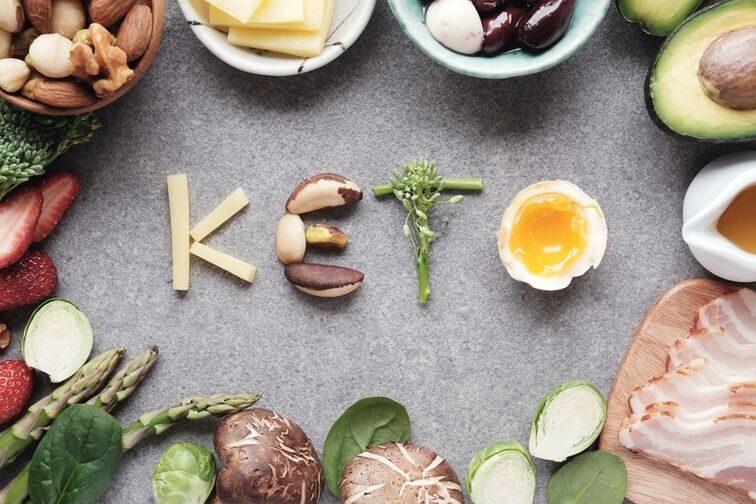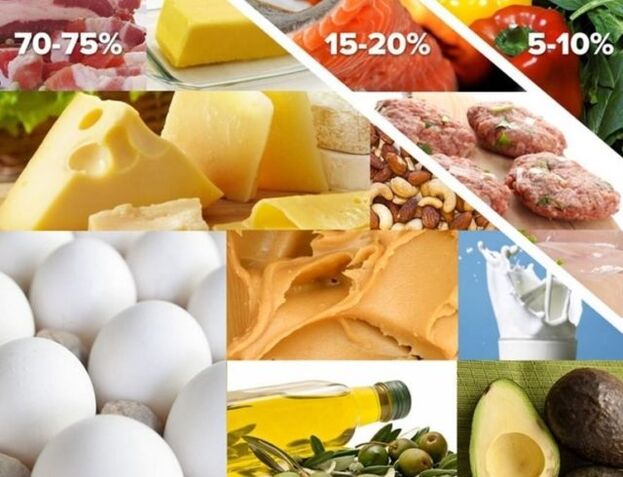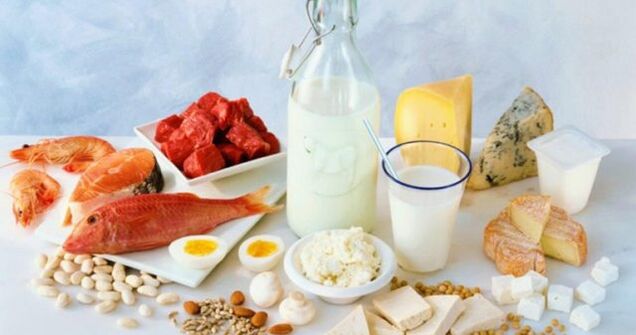The keto diet was developed in 1921 to treat epilepsy. Later, bodybuilders started using it to build muscle. Only a reduced intake of carbohydrates and a small amount of protein can be used to use fat for fuel -- these are the principles of the ketogenic diet.
What is the keto diet?
The ketogenic, keto, or keto diet (keto) is a diet that is low in carbohydrates, moderate in protein, and high in fat.
When carbohydrates are consumed, they lead to the formation of glucose and the production of insulin. Glucose is most easily consumed by the body as fuel. Insulin is required to bring glucose into cells. In these cases, the fat remains unclaimed and just accumulates. But if carbs are cut back, the body is forced into a state of ketosis—a natural process when the body starts using fat for fuel.

In the liver, ketone bodies are formed from free fatty acids when glucose is deficient. Ketones or ketone bodies are molecules that carry energy for the body to function. The goal of keto is to become this state.
There are 4 types, 3 for athletes and one for all other ketosis supporters:
- Standard: Basic Ketones - Percent BJU - 20: 75: 5.
- Purposeful: Carbohydrate intake increases during exercise due to exercise.
- Periodic: Higher carbohydrate intake, such as weekends.
- High protein: instead of reducing protein, it increased to about 35%. The overall ratio of BJU becomes - 35: 60: 5.
Approved product
The following products are permitted:
- Any meat: veal, pork, poultry, etc. Do not remove fat from meat and chicken.
- In chicken, thighs and legs are preferred.
- Fish and seafood: Any, but fatty fish is better - salmon, mackerel, sardines, anchovies, salmon and herring, shrimp and squid.
- Eggs: any form.
- Natural fats: lard and lard, ghee for frying, salted butter, coconut oil, avocado, flaxseed, and olive oil for salads.
- Nightshade vegetables: kale, zucchini, eggplant, asparagus, olives, spinach, lettuce, greens, and leafy greens.
- Mushrooms: Any.
- High-fat dairy products only: whole milk (over 3%), heavy cream (20-40%), sour cream 25%, cottage cheese, Greek yogurt, fatty hard cheeses.
- Oil Nuts and Seeds: Macadamia nuts, cashews, walnuts, sunflower seeds, pumpkin seeds, etc.
- Berries: Small amounts - raspberries, blackberries, blueberries.

Occasionally allow:
- Alcohol: Dry wine, unsweetened spirits (gin, rum, whiskey, vodka), unsweetened cocktails.
- Dark Chocolate: Very moderate, with over 70% cocoa.
- Water, coffee with cream, tea and herbal tea to suit your taste.
- Chicken stock or bouillon cubes with at least 1 gram of sodium. When carbohydrates are reduced, glycogen is actively consumed. For 1 gram of it, 3 grams of water are needed. With it, the sodium the body needs is also gone. According to nutritionists, chicken broth is essential in this diet because it provides the body with sodium.
Prohibited Products:
- Sweets - sugar, candies, cakes, ice cream, honey, maple syrup, agave.
- Sugar-sweetened beverages – soda, juice, milk-based coffee, beer, etc.
- Grains, cereals and rice are rich in carbohydrates.
- Sweet fruits - bananas, apples, grapes, oranges, pears, mangoes, pineapples, etc.
- Beans are rich in carbohydrates.
- Potatoes are rich in starch.
- Store-bought sauces - ketchup and barbecue sauce.
- Margarine - no benefit at all.
- Artificial trans fats - sometimes worsen health.
important! The more restricted (less than 15 grams of carbs per day), the faster a person will enter a state of ketosis.
Keto Diet: Menu
| breakfast | Lunch | dinner | afternoon tea | dinner | |
|---|---|---|---|---|---|
| on Monday | Asparagus, Bacon, Fried Eggs, Creamy Coffee | high-fat cottage cheese; salad and chocolate | Coconut Fried Chicken Breast, Fried Mushrooms, Spinach, Avocado and Lime Juice | boiled beef; some nuts and rose hip infusion | Olive oil tuna steak with peppers and garlic, sauteed broccoli and sprouts, roasted tomatoes |
| Tuesday | coffee with butter or ghee, 3 hard boiled eggs | fat cheese | Beef sliced, tomato, lettuce leaves stir-fried with bacon; meatballs and fish soup | cheese | low carb chicken grandmasala (spice mix); salmon, cheese toast, tea |
| Wednesday | Fried Mushrooms and Bell Pepper Omelettes in Olive Oil; Cream with Cream | cottage cheese | Bacon, Avocado and Feta Salad; Herb Broth, Chicken Chop | 3 eggs omelette; green tea, nuts. | Tonkatsu with Mayo and Onions; Green Apple Puree |
| Thursday | steak, croutons | Turkey meat, green tea. | Ground beef soup; barracuda meatballs; sautéed cabbage and broccoli with egg salad, unsweetened preserves. | Rosehip Soup, Chicken Breast | Avocado and Shrimp in Creamy Mayonnaise and Chili Sauce |
| Friday | Bacon Cauliflower Scrambled Eggs | cheese, green salad, dogwood broth | Fish soup with meatballs, chicken soufflé, papaya soup. | Zucchini Slices, Vegetable Salad | Turkey, Tomato, Mushroom and Parmesan Noodles |
| Saturday | Cauliflower Pizza | Soft cheese and green tea | Steak, croutons, butter coffee | Salmon Salad with Tomatoes and Cranberries | Low Carb Beef with Chili Sauce and Garlic |
| Sunday | Bacon Pie and Salad | 3 hard-boiled eggs, biscuits, unsweetened preserves | Red fish, cheese toast | Chicken Caesar Salad with Parmesan | Beef Sauce, Kefir |
who is banned from this diet
Keto Diet Contraindications:
- diabetes
- hypertension;
- Hypercholesterolemia;
- kidney and gastrointestinal diseases;
- Decompensation of cardiac activity;
- during pregnancy and breastfeeding.

The benefits and harms of the ketogenic diet
Diet benefits:
- Effectively solve the problems of weight loss, muscle gain and body dryness;
- regulate blood sugar levels;
- Help manage type 2 diabetes
- improve cognitive ability;
- normalizes cholesterol and blood pressure;
- cleans acne-prone skin;
- Helps people with epilepsy reduce the number of anticonvulsants they take;
- Useful for Alzheimer's disease and Parkinson's disease;
- Economically inexpensive;
- Dishes are not difficult to prepare.
shortcoming:
- low carb, unbalanced
- not shown to everyone;
- Decreased work ability and memory.
A nutritionist's view on the ketogenic diet
The ketogenic diet focuses on protein and fatty foods and is extremely low in fiber. This is full of bloating and heavy stomach, constipation. In addition, the gut is colonized by pathogenic microorganisms, which ultimately lead to dysbiosis. Reduced immunity. To avoid such problems, at least consume fiber to a minimum - cabbage, apples, sour grapes.
A big disadvantage is the lack of carbohydrates, to which the body does not respond adequately.
If physical activity is higher than the body is capable of, this can trigger low blood sugar in the form of weakness, decreased stress, dizziness, nausea, fainting and collapse. To prevent it, it's best to snack on fruit juices and semisweet fruits, and drink honey tea at the first signs of hypoglycemia.

Glucose deficiency reduces brain function. Cognitive components—attention, concentration, memory—are particularly affected. After reaching the ketosis stage, they partially recover, but the levels are still not at the level they were before. Therefore, it is better not to use this diet when passing exams, hard mental work.
A ketogenic diet can lead to kidney stones, dehydration, elevated blood cholesterol levels, constipation, and gout attacks. Ketones are deficient in essential minerals and vitamins, so take a vitamin complex.
Keto will certainly improve the body, keep metabolism off the ground and lose weight, but transitioning to this particular diet is very difficult and requires consultation with a doctor. The keto diet isn't for everyone. Only after the doctor has examined the current situation can they say whether it is permissible to start a diet.






























